Mastering Smoked Turkey: Essential Preparation Tips

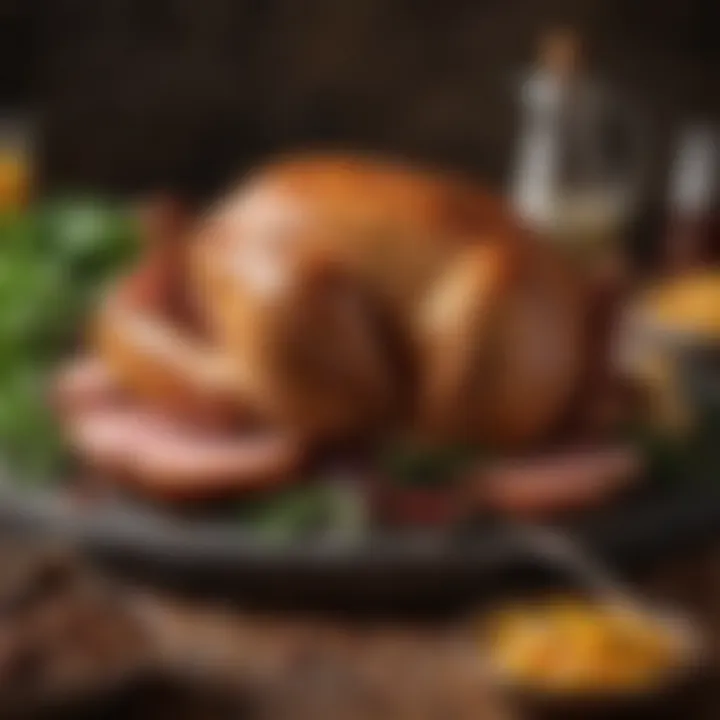
Intro
Recipe Highlight
For our featured recipe, we present the Herb-Infused Smoked Turkey. This turkey is not just a dish; it’s a centerpiece that brings flavor and joy to any gathering.
To prepare this dish, you will need the following essential ingredients:
- One whole turkey (10-12 pounds)
- Olive oil
- Fresh herbs (such as rosemary, thyme, and sage)
- Garlic cloves, minced
- Salt and pepper
- Wood chips for smoking (hickory or applewood recommended)
The estimated time to prepare the meal is about 15 hours, which includes a 12-hour brining, plus cooking and resting time. This recipe yields around 10 servings, making it perfect for a family gathering or special occasion.
Step-by-Step Instructions
- Brining the Turkey: Start by preparing a brine solution using water, salt, and any preferred spices. Submerge the turkey in this solution for at least 12 hours; this step is crucial for flavor enhancement and moisture retention.
- Prepping the Turkey: After brining, rinse the turkey under cold water and pat it dry. Apply a generous amount of olive oil on the skin. Mix minced garlic with chopped fresh herbs, salt, and pepper, then rub this mixture underneath the skin and over the turkey.
- Prepare the Smoker: Soak wood chips in water for 30 minutes before using. Set up your smoker according to the manufacturer’s instructions. Preheat it to a steady temperature of 225°F (107°C).
- Smoking: Place the turkey breast side up in the smoker. Add soaked wood chips to generate smoke. Cook the turkey until it reaches an internal temperature of 165°F (75°C), which could take about 6-8 hours, depending on the size.
- Resting: Allow the turkey to rest covered in aluminum foil for about 30 minutes before carving. This step helps retain juices.
Insider advice: Avoid frequently opening the smoker. This lets heat escape and can prolong cooking time.
Variations and Substitutions
For those looking to tailor flavors, consider these variations:
- Substitute olive oil with melted butter for a richer taste.
- Add lemon zest to the herb mixture for a citrusy twist.
- If you are vegetarian, consider making a smoked vegetable platter using similar herb rubs with bell peppers, zucchinis, and mushrooms.
Pair your smoked turkey with classic sides like mashed potatoes, cranberry sauce, or coleslaw to elevate your dining experience.
Time-Saving Cooking Tips
Efficiency can enhance your cooking experience. Here are some strategies:
- Prep in Advance: Chop herbs and garlic a day before. Store them in the fridge to save time.
- Use a Meat Thermometer: A digital meat thermometer ensures accuracy in internal temperature, preventing overcooking.
- Multi-purpose Tools: Invest in gadgets like food processors and smokers with precise temperature controls to simplify tasks.
You can also prepare side dishes while the turkey cooks, maximizing your time.
Nutritional Information
For one serving of herb-infused smoked turkey (around 4 oz), you might expect:
- Calories: approx 250
- Protein: 38g
- Fat: 10g
- Carbohydrates: 0g
This dish is low in carbs and high in protein, making it suitable for various dietary plans including high-protein and keto diets, though not for strict vegan or vegetarian diets. The fresh herbs used add vitamins and antioxidants, increasing the meal’s health benefits.
Remember, a perfectly smoked turkey is not just about following the steps. It’s about enjoying the process and embracing the flavors that develop along the way.
Understanding Smoked Turkey
Smoking turkey is not just a method of cooking; it is an art that enhances flavor and texture. Understanding the nuances of smoked turkey is crucial for any cook aiming to elevate their culinary repertoire. The appeal goes beyond taste. It embodies a tradition, an experience, and a culinary technique that merits attention.
The Appeal of Smoking
The smoking process introduces a depth of flavor that cannot be replicated by other cooking methods. It works by infusing the meat with rich smokiness, enhancing its natural flavors. This unique approach is achieved by using wood chips of various types. Each type contributes a distinct aromatic profile to the turkey. This offers not just a meal, but an experience to savor. The slow cooking process also ensures moist meat, tenderizing even the toughest cuts.
Many people associate smoked turkey with gatherings and celebrations. It stands out during festive seasons like Thanksgiving or family barbecues, making it a centerpiece. The aroma that fills the air while the turkey smokes is an enticing promise of the delicious meal to come.
Benefits of Smoked Turkey
Smoked turkey is not only a treat for the taste buds but comes with several practical benefits, making it a desirable choice.
- Flavor Versatility: The method allows cooks to experiment with spices and woods. This versatility provides an opportunity for customization based on personal preferences.
- Health Consciousness: Compared to deep-fried or heavily sauced alternatives, smoked turkey is often leaner and healthier. It retains fewer calories while maintaining substantial flavor.
- Leftovers Acclaimed: Smoked turkey often tastes even better the day after. The flavors meld and deepen, making it a popular choice for sandwiches, salads, or soups.
These elements make smoked turkey an appealing option for cooks who want to offer something special while also staying mindful of health and wellness.
Selecting the Right Turkey
Choosing the right turkey is fundamental to achieving a successful smoked turkey. The selection process involves various significant considerations, which directly influence the flavor, texture, and overall quality of the final dish. A well-selected turkey provides a solid foundation for the smoking process, ensuring that the natural flavors are enhanced rather than compromised.
Whole vs. Parts
When deciding between a whole turkey and parts, it is essential to understand how each option affects the smoking process. Whole turkeys yield a more complex flavor profile as the smoke permeates the entire bird, providing a consistent taste throughout. Additionally, the presentation of a whole turkey can be visually striking, making it ideal for gatherings.
On the other hand, turkey parts, such as breasts, thighs, and drumsticks, offer convenience and faster cooking times. They can also allow for unique flavor pairings during the seasoning or brining stages. However, smoking parts might require close attention to ensure even cooking and flavor absorption. In summary, the choice between whole and parts depends on your cooking objectives, the expected number of guests, and your preferred flavor experience.
Size Considerations
Size is a crucial factor in turkey selection, particularly for smoking. A larger turkey generally results in longer cooking times, demanding more attention for proper temperature control. Most cooks recommend selecting a turkey that weighs between 12 to 16 pounds for optimal smoking results. This size balances cook time and the ability to infuse flavor without drying out the meat.
It is worth noting that larger birds may benefit from a longer brining period to evenly distribute seasoning and moisture. Conversely, smaller turkeys can cook more quickly but may require strategic placement in the smoker to ensure a uniform smoke flavor. When selecting a turkey, always consider the average portion size for your guests to avoid waste or insufficient servings.
Fresh vs. Frozen
The decision to choose between a fresh or frozen turkey significantly impacts the quality and flavor of the finished product. Fresh turkeys, often available close to holidays, typically provide superior taste and texture. They have not undergone freezing, preserving their natural moisture and flavor.
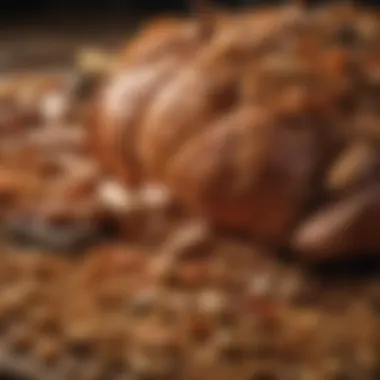
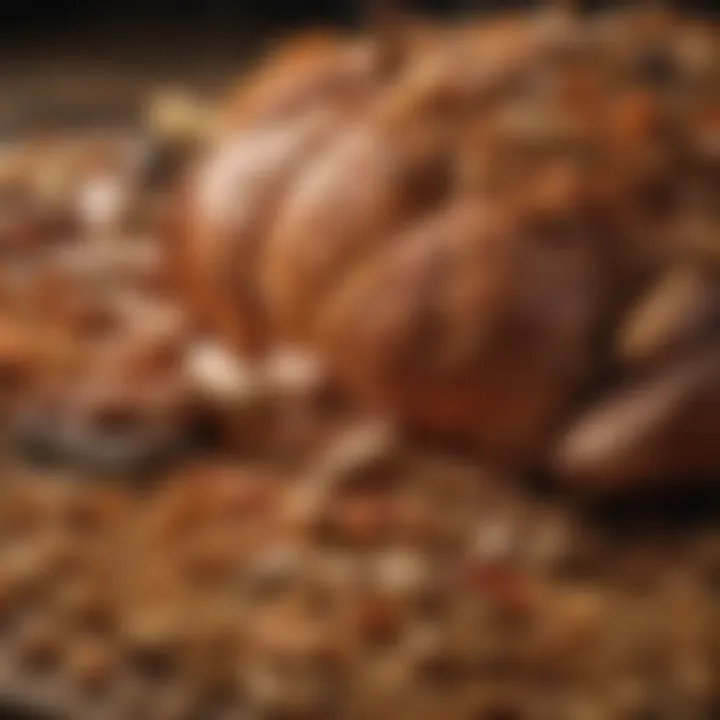
However, frozen turkeys can be just as effective if appropriately thawed and handled. Proper thawing methods, such as refrigeration or cold water baths, are critical to prevent bacterial growth. It is advisable to allow at least 24 hours of thawing time for each 4 to 5 pounds of turkey. In contrast, frozen turkeys retain moisture for an extended period, allowing flexibility in purchasing ahead of time.
"Selecting the right turkey can make or break your smoking experience. Pay attention to details and choose wisely."
In summary, the choice between fresh and frozen turkey comes down to planning and preparation. For purity of flavor, fresh is preferred. For convenience and flexibility in timing, frozen is a valued option.
Preparing the Turkey
Preparing the turkey is a crucial step in the process of smoking. It sets the foundation for achieving a flavorful and tender result. This section will guide you through the essential techniques to get your meat ready for the smoker.
Thawing Techniques
Before you smoke your turkey, it needs to be properly thawed. A slow thaw in the refrigerator is the safest method. This process may take a few days, depending on the size of the bird. This method keeps the turkey at a safe temperature and prevents bacterial growth.
Another alternative is cold water thawing. You submerge the turkey in cold water, changing the water every 30 minutes. This method is quicker, but it requires more attention to ensure that the water remains cold enough.
Brining Methods
Brining is essential for infusing moisture and flavor into the turkey. It can be done in two ways: wet brining and dry brining.
Wet Brining
Wet brining involves soaking the turkey in a saltwater solution. This method helps the turkey retain moisture during the smoking process. A key characteristic of wet brining is that it can include additional flavor components, such as herbs, spices, and sugar.
Wet brining is a popular choice because it significantly improves juiciness. However, it requires space for the brining container and can be a bit messy. The advantage is a deeply flavorful turkey that won't dry out.
Dry Brining
Dry brining entails rubbing salt directly onto the turkey skin and allowing it to rest. This method draws out moisture, which then gets reabsorbed, enhancing the flavor. A key characteristic of dry brining is its simplicity; it requires no additional liquid.
This technique is advantageous for maintaining a crisp skin, yet it may not yield as juicy a turkey as wet brining. To achieve optimal flavor, dry brining is often done with spices mixed into the salt, providing additional depth.
Timing and Proportions
The timing and proportions when brining are vital. For every pound of turkey, generally, 1 to 1.5 hours of brining time is suggested. Proportions should be consistent, usually about 1 cup of salt for each gallon of water in wet brining. Timing can significantly change the turkey; under-brining may result in bland meat while over-brining can lead to overly salty and tough turkey. This precision is beneficial to achieve the desired taste and moisture.
Seasoning Options
Once the turkey is thawed and brined, the next step is seasoning. This can greatly vary depending on personal taste or regional preferences. You may use simple salt and pepper or experiment with various spices. Common choices include garlic powder, onion powder, and smoked paprika.
You could also try herb blends, which can elevate the flavors. Applying seasoning evenly and generously is necessary to ensure the entire bird is infused with flavor. Each seasoning option contributes differently, so explore and find a combination that suits you best.
Selecting Equipment
Selecting the right equipment for smoking turkey is crucial. The equipment influences the cooking process and the final flavor. Understanding different smoker types and essential tools helps achieve optimal results and enhances the experience.
Types of Smokers
Electric Smokers
Electric smokers are popular for their convenience. The user can set the temperature and let it work while focusing on other tasks. This type of smoker maintains consistent heat, resulting in evenly cooked turkey. One key characteristic of electric smokers is their ease of use. The drawback may be that electric smokers do not provide the same depth of flavor as traditional methods. They rely more on temperature control than on wood smoke, which is less appealing for some enthusiasts.
Charcoal Smokers
Charcoal smokers offer a classic approach to smoking. They are favored for the rich flavor that charcoal can impart to the meat. These smokers require a bit more attention, as managing the charcoal and temperature can be tricky. However, many cooks appreciate the challenge. A characteristic of charcoal smokers is their ability to foster a truly smoky flavor thanks to the burning coal. The main disadvantage here is the learning curve and the time investment needed for adequate fuel management.
Wood-Fired Smokers
Wood-fired smokers represent a pure form of smoking. They are appreciated for delivering complex flavors through wood choice. This type requires careful handling, as smoke can be pungent or overwhelming if not controlled. The unique feature of wood-fired smokers is the flexibility in choosing different types of wood, each imparting distinct flavors. However, they demand more skill and understanding of how to balance smoke and heat, which can deter some cooks aiming for simplicity.
Essential Tools
Thermometers
Thermometers are an invaluable tool in turkey smoking. They ensure that the turkey reaches the proper internal temperature, enhancing food safety and flavor. A good thermometer provides precise readings, helping to avoid overcooking. The popularity of thermometers in this context stems from their ability to take the guesswork out of cooking. They come in various forms, such as instant-read and probe thermometers. While they are essential, reliance on them may lead to ignoring other sensory cues, like smell or texture, which are also important in cooking.
Smoking Chips
Smoking chips provide the wood flavor that enhances the meat. Different types of chips, like hickory, mesquite, and apple, contribute unique tastes. The characteristic of smoking chips is their versatility; they can be mixed for custom flavor profiles. They are widely used due to their accessibility and ease of use. A disadvantage is that they can burn too quickly, resulting in less effective smoking if not monitored closely.
Grill Grates
Grill grates play a supportive role in the smoking process. They help with heat distribution and hold the meat securely during cooking. The key characteristic of grill grates is their role in promoting even cooking. Many smokers come with grates designed for optimal airflow, allowing smoke to circulate effectively around the turkey. One slight drawback is that not all grates have the same durability, which could affect long-term use. A higher quality grate may come at a greater cost but offers better performance.
"Selecting the right equipment and tools sets the stage for a successful smoking experience."
This section aims to highlight how crucial equipment choice is for achieving the desired quality and flavor in smoked turkey.
Smoking Process
The smoking process is a fundamental aspect of preparing smoked turkey. It determines not only the final taste of the meat, but also its texture and presentation. Proper smoking techniques enhance flavors and tenderize the meat, making it more enjoyable for consumption. Understanding the nuances of this process can elevate your cooking skills and impress your guests.
Setting Up the Smoker


Setting up the smoker is vital for ensuring a successful smoked turkey. It requires attention to detail, especially in two key areas: temperature control and fuel preparations.
Temperature Control
Temperature control is a critical aspect of the smoking process. It directly influences how evenly the turkey cooks. A consistent temperature can help prevent overcooking or undercooking, ensuring a tender and juicy final product. The ideal smoking temperature for turkey typically ranges from 225°F to 250°F. This low and slow approach allows the flavors of the wood to penetrate the meat effectively.
One key characteristic of temperature control is monitoring. Using a reliable thermometer is beneficial. It helps maintain the desired cooking temperature and avoids fluctuations that can lead to uneven results. This practice is particularly important for those who are new to smoking.
Unique features of good temperature control include the ability to adjust air supply, which can change the temperature in the smoker. However, maintaining consistent heat can be challenging with certain types of smokers, like charcoal models, that require regular adjustments. Proper management of temperature benefits both flavor and texture of the turkey.
Fuel Preparations
Fuel preparations involve selecting and managing the type of fuel you will use in the smoking process. This factor greatly impacts the flavor profile of the turkey. Common fuel sources include charcoal, wood, or gas, each contributing different characteristics to the smoke.
The key characteristic of fuel preparations is choosing the right type of wood for smoke flavor. Various woods, such as hickory or cherry, impart unique flavors that enhance the turkey. Therefore, it is a popular choice among many chefs for its ability to adjust flavor intensity.
One unique feature of fuel preparations is the need for pre-soaking wood chips or using dry wood. While soaked chips create a longer smoke duration, dry wood burns hotter and reduces the smoke flavor intensity. Both approaches have their advantages and disadvantages. Choosing the appropriate fuel source and method is essential to achieve the desired outcome in smoked turkey.
Smoking Techniques
Using the right smoking techniques can further influence the quality of the smoked turkey. Two significant techniques to consider are indirect heat and the choice between hot smoking and cold smoking.
Indirect Heat
Indirect heat refers to a cooking method where the heat source does not directly touch the turkey. This method allows the turkey to cook gently and is a defining characteristic of effective smoking. It ensures that the meat becomes tender while absorbing the smoke flavor over a prolonged period.
This cooking method is beneficial because it prevents flare-ups, which can lead to charring on the surface of the turkey. Instead, it facilitates a uniform cooking experience. Indirect heat provides a steady temperature, making it easier to manage during the smoking process. However, it can require more attention and setup compared to direct heating methods.
Hot Smoking vs. Cold Smoking
Hot smoking and cold smoking are two approaches that differentiate how smoke interacts with the turkey. Hot smoking, typically carried out at temperatures above 180°F, cooks the turkey while infusing it with smoke. This method yields a well-cooked product that is ready to serve.
In contrast, cold smoking occurs at temperatures below 85°F. This method is not common for complete cooking but can be used to enhance flavor. It is often employed in conjunction with another cooking method later on.
The unique feature of hot smoking is its capacity to ensure food safety. Since it cooks the turkey thoroughly, it reduces the chances of harmful bacteria. Cold smoking, on the other hand, demands careful attention to food safety guidelines as it does not cook the meat but merely imbues it with flavor. Understanding these two techniques will help you select the most appropriate method for your preferences.
Monitoring Internal Temperature
Monitoring the internal temperature is crucial in the smoking process. This method ensures that the turkey has reached a safe temperature for consumption. An ideal internal temperature for turkey is 165°F. Consistently checking this temperature upholds food safety and guarantees a moist and flavorful turkey.
"Monitoring internal temperatures is key to ensuring a safe and enjoyable turkey experience."
In summary, the smoking process is intricate with elements like temperature control, fuel preparations, and smoking techniques crucial for the perfect smoked turkey. Each detail contributes to achieving not only safety but also distinct flavors and textures.
Finishing Touches
Finishing touches are vital in the overall preparation of smoked turkey. They can significantly enhance the flavor and presentation, making the experience not only satisfying but also memorable. After dedicating time to ensure that the turkey is properly smoked, these steps can elevate the final product beyond expectations. This section will discuss three essential aspects of finishing the turkey: resting, carving, and serving suggestions.
Resting the Turkey
Resting the turkey is a critical step that should not be overlooked. After the smoking process is complete, it is essential to allow the meat to sit for a period. This resting stage usually lasts between 20 to 30 minutes. The purpose of resting is to let the juices redistribute throughout the meat. If you carve the turkey immediately, juices will run out, resulting in dry slices, which is not desirable.
During this time, it is advisable to loosely cover the turkey with aluminum foil. This covering helps retain warmth while avoiding moisture loss. Keep the turkey in a warm place to ensure it does not cool down too much before serving. The balance of temperature and moisture is crucial for providing the best flavors and textures.
Carving Techniques
Carving techniques can significantly impact the presentation and enjoyment of the smoked turkey. A poorly carved turkey can look uninviting, while well-carved slices entice the eater. Begin by ensuring that you have a sharp carving knife. A good knife will make cleaner cuts, preserving the meat's structure and appearance.
- Remove the Legs and Thighs: Start by cutting through the skin around the joint that connects the leg to the body. Pop the joint by gently bending it back, and then cut through the joint to detach the leg and thigh.
- Slice the Breast Meat: Position the turkey breast side up. Make a cut along one side of the breastbone and gently pull the meat away while slicing downward.
- Serve in Uniform Slices: Aim for even, uniform slices, about half an inch thick. This size allows for easier serving and better plate presentation.
Taking care in carving not only enhances the aesthetic appeal but also ensures that diners receive the best portions of meat.
Serving Suggestions
The presentation of the smoked turkey plays a significant role in the dining experience. There are several creative serving suggestions that can include simple garnishes or more elaborate arrangements. Here are a few ideas:
- Garnish with Fresh Herbs: Using rosemary, thyme, or parsley can enhance the visual appeal and add a fresh aroma.
- Create a Display on a Platter: Arrange the carved meat on a large platter, mixing pieces from different parts of the turkey. This showcases variety and encourages guests to try every part.
- Pair with Complementary Sides: Smoked turkey pairs well with sides like cranberry sauce, stuffing, or grilled vegetables. This can create a complete meal and appeal to various palates.
Safety Considerations
Safety is a crucial aspect when preparing smoked turkey. Cooking meat at home carries inherent risks, particularly when it involves larger poultry like turkey. The objective is to ensure that every bite is safe to consume while maintaining flavour and texture. Failures in food safety can lead to foodborne illnesses, which are severe and sometimes life-threatening. Therefore, understanding and implementing safety measures must be a priority for any home cook.
Food Safety Guidelines
To safely prepare smoked turkey, adhering to established food safety guidelines is essential. Here are key recommendations:
- Maintain Cleanliness: Always wash hands, utensils, and surfaces before and after handling raw turkey.
- Proper Thawing: If using a frozen turkey, thaw it safely. The best methods are refrigeration over several days or cold water thawing. Avoid counter thawing.
- Temperature Control: The USDA recommends cooking turkey to an internal temperature of 165°F (74°C). To be sure, use a reliable meat thermometer. Insert it into the thickest part of the turkey, avoiding bones.
- Avoid Cross-Contamination: Keep raw turkey separate from other foods, especially those consumed raw, such as vegetables and fruits.
- Cook Thoroughly: Ensure the turkey is cooked evenly to avoid undercooked areas. Understanding the smoking process aids in maintaining consistent temperatures.
Following these guidelines will prevent most food safety hazards in turkey preparation and lead to a safer, enjoyable dining experience.
Handling Leftovers
Leftovers can often be an overlooked aspect of cooking, yet they require careful handling to avoid spoilage and foodborne illnesses. Here are crucial tips for dealing with leftover smoked turkey:
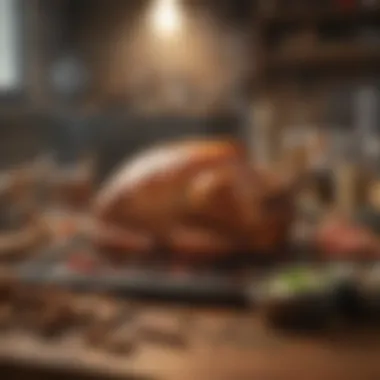
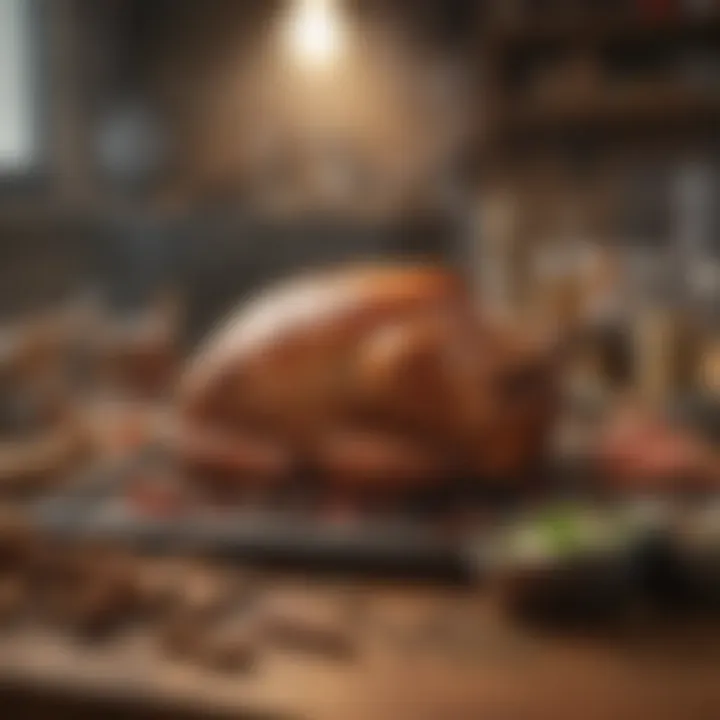
- Cool Promptly: Refrigerate any leftover turkey within two hours of cooking. Allowing turkey to sit at room temperature encourages bacterial growth.
- Storing Properly: Store leftovers in airtight containers. This prevents moisture loss, and cross-flavors while keeping the meat safe from contaminants.
- Reheating Safely: When reheating, ensure the turkey reaches a minimum temperature of 165°F (74°C). This applies no matter how long it has been stored. For best results, use the oven or stovetop rather than microwaving, which can heat unevenly.
- Storage Time Limits: Consume or freeze leftovers within four days. If frozen, use within six months for best quality.
- Identifying Spoilage: Always check for signs of spoilage before consuming. Off smells, discoloration, or slimy texture indicate that the turkey should be discarded.
Adhering to these safety considerations not only protects health but enhances the overall culinary experience, enabling the home cook to focus on creativity and flavour.
Common Pitfalls
When preparing smoked turkey, one must navigate various challenges that can affect the flavor and texture. Awareness of these common pitfalls can significantly improve the final product. Let’s explore two of the most frequent issues: over-seasoning and inconsistent smoking temperature. Understanding these factors not only enhances the taste but also reduces frustration during the cooking process.
Over-Seasoning
One of the most prevalent mistakes is over-seasoning, which can easily detract from the natural flavors of the turkey. It is essential to understand that the smoking process itself infuses the meat with rich, complex flavors. Therefore, additional seasonings should complement rather than overwhelm the turkey.
- Strategic Application: Start with a moderate amount of seasoning. A well-balanced rub should enhance flavor without becoming dominant. Consider using salt as the primary seasoning, due to its ability to draw out moisture and create a flavorful crust.
- Tasting Beforehand: A practice that can help mitigate over-seasoning is sampling the seasoning mix prior to application. This allows adjustments to be made before it impacts the entire turkey.
- Resting Period: Allow the turkey to rest after seasoning. This helps to draw out the flavors naturally, giving you a better sense of the taste before committing to additional spices.
Inconsistent Smoking Temperature
Another critical aspect of successfully smoking turkey is maintaining a consistent temperature throughout the cooking process. Fluctuations in temperature can lead to uneven cooking, resulting in some parts being undercooked while others may be dried out.
- Monitoring Tools: Use a reliable thermometer to keep track of internal and external temperature. Digital thermometers provide accurate readings and can alert you to changes that may require adjustments in fuel or airflow.
- Setting Up the Smoker: Make sure the smoker is set up correctly before placing the turkey inside. This includes preheating the smoker to the desired temperature, typically between 225°F and 275°F for turkey.
- Fuel Consistency: The type of fuel used can greatly affect temperature control. Charcoal may require more attention to maintain an even burn, while electric smokers often provide more stability.
The key to avoiding these pitfalls lies in careful preparation and a thoughtful approach to the cooking process. By taking the time to season appropriately and monitor the temperature, the chances of achieving a perfectly smoked turkey increase significantly.
"Understanding these common pitfalls can lead to a more enjoyable cooking experience and tastier results."
Enhancing Flavor Profiles
Enhancing flavor profiles is crucial in achieving a memorable smoked turkey. This aspect allows cooks to explore diverse tastes that transform a simple turkey into a culinary masterpiece. Selecting suitable elements for flavor enhancement can influence the overall experience of the dish. Both wood choices and marinades or glazes play significant roles in this process.
Wood Choices
The selection of wood is one of the most impactful decisions you will make when smoking turkey. Different types of wood impart unique flavors that can either complement or overwhelm the natural taste of the meat. Understanding these nuances can guide your choices adequately.
- Hickory: This is a popular choice among many pitmasters, known for its strong and bold flavor. It can be overpowering if used excessively, so moderation is key.
- Mesquite: This gives a distinctly robust taste. It burns hot and fast, which means you need to control your smoking time to avoid bitterness.
- Applewood: This wood offers a subtle, fruity flavor that enhances the turkey's tenderness without being intrusive. It's suitable for those who prefer a milder smoke.
- Cherrywood: Similar to apple but sweeter, cherrywood provides a rich, rosy color to the meat, along with a balanced flavor profile.
Understanding these choices allows you to tailor the flavor of your smoked turkey effectively, considering your personal preferences and those of your guests.
Using Marinades and Glazes
Marinades and glazes are essential elements in flavor enhancement. They serve both a functional and aesthetic purpose, contributing moisture and visual appeal to the turkey. The key benefits include:
- Moisture Retention: Marinades help to retain moisture during the smoking process, creating a juicier end product.
- Flavor Infusion: You can create complex layers of taste by utilizing various ingredients in your marinades and glazes. Common components include garlic, herbs, and citrus.
- Visual Appeal: A well-applied glaze lends an attractive sheen to the turkey, making it more appealing when served.
When preparing your marinade or glaze, consider the following:
- Acidic Components: Ingredients like vinegar, citrus juice, or wine can help break down the meat fibers, making it more tender and flavorful.
- Seasoning Balance: Ensure that you balance salty, sweet, and bitter elements to achieve the desired flavor complexity.
- Application Timing: Apply marinades before smoking to allow flavors to penetrate the meat. Glazes can be brushed on during the last stages of cooking for a beautiful finish.
Incorporating these elements of flavor enhancement will elevate your smoked turkey, ensuring a delicious and satisfying dish that leaves a lasting impression.
Tip: Experiment with different wood choices and marinade combinations to discover your favorite flavor profiles.
Exploring Variations
Exploring variations in smoked turkey preparation opens up a world of culinary potential. Different flavor profiles and regional inspirations not only enhance the taste but can also create a unique experience for those who consume it. Adapting your method or ingredients according to tradition or personal preference can lead to a more satisfying dish. It broadens one’s flexibility in the kitchen and showcases creativity. Thus, exploring variations is a pathway to personal expression through food.
Regional Flavor Influences
Regional influences can shape the way smoked turkey is prepared, showcasing local ingredients and culinary traditions. In the Southern United States, for instance, a robust flavor profile that combines spices such as paprika, cayenne, and garlic powder is common. The emphasis is on a slightly sweet dry rub that enhances the meat's natural juices when smoked.
Meanwhile, in the Pacific Northwest, chefs may turn to applewood or cherrywood for a fruitier smoke flavor. This method often incorporates herbs like rosemary and thyme, reflecting the region's fresh and earthy characteristics. The variations in wood choices and seasoning can highlight distinct local flavors, providing a richer experience.
Consider these techniques:
- Dry Rubs: These can vary in spice and sweetness, often reflecting the region.
- Brining with Local Ingredients: Some might use local beers or ciders in their brine for a unique twist.
Regional variations not only diversify flavors but also honor local cultures and traditions.
Smoked Turkey in International Cuisines
International cuisines offer diverse approaches to smoked turkey, enriching its preparation. Countries around the world feature unique techniques and flavors that can inspire new takes on this classic dish. For example, in Latin America, citrus juices such as orange or lime can marinate the turkey, providing a bright, tangy addition before smoking.
Asian cuisines also present intriguing possibilities. In places like Thailand, one can incorporate lemongrass and ginger into the brine or marinade. This not only tenderizes the meat but infuses it with fragrant, aromatic flavors that are distinct.
Here are some influences to consider:
- Teriyaki-Inspired Marinades: Soy sauce, sesame oil, and ginger can bring a touch of umami to smoked turkey.
- Mediterranean Touches: Using olive oil and lemon zest can offer a refreshing flavor boost.
Engaging with these international styles introduces variety and makes the culinary process all the more exciting.
End
In summary, expressing the conclusion of this article is vital as it wraps together key insights into smoked turkey preparation. The practice of smoking turkey can transform a common dish into a flavorful centerpiece. Each aspect discussed from selecting the right turkey to smoking techniques plays a role in achieving a perfectly smoked product. Recognizing these elements helps cooks enhance their culinary endeavors and share impressive meals with family and friends.
By recap-ing major points, readers consolidate knowledge gained throughout the article. The emphasis on safety, especially food handling, remains critical. Every detail contributes to a memorable experience. Smoked turkey is often associated with gatherings and celebrations, making the preparation process a significant part of the occasion.
Furthermore, encouraging readers to experiment fosters creativity in the kitchen. With various regional influences and wood choices, cooks can adjust flavors to their preferences.
"Experimentation is the heart of culinary art, allowing for personalization and masterful creations."
In essence, as home cooks grasp these tips, their confidence in cooking smoked turkey flourishes. The journey not only involves mastering techniques but also discovering unique flavor profiles, offering an artful way to celebrate occasions with delicious food.







